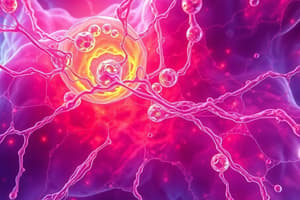Podcast
Questions and Answers
What is the main role of collagen in the extracellular matrix?
What is the main role of collagen in the extracellular matrix?
- Provides hydration to the tissue
- Promotes elasticity and stretchiness
- Facilitates cell communication
- Provides structure and strength (correct)
What is NOT a characteristic of the extracellular matrix?
What is NOT a characteristic of the extracellular matrix?
- It influences tissue structure and function.
- It is secreted by cells.
- It can fill spaces between cells.
- It consists only of proteins. (correct)
Which tissue type primarily provides protection and serves as a barrier?
Which tissue type primarily provides protection and serves as a barrier?
- Epithelial Tissue (correct)
- Connective Tissue
- Nervous Tissue
- Muscle Tissue
What effect does the presence of proteoglycans have on cartilage tissue?
What effect does the presence of proteoglycans have on cartilage tissue?
Which component serves as the 'glue' connecting cells to each other in the extracellular matrix?
Which component serves as the 'glue' connecting cells to each other in the extracellular matrix?
In which level of tissue organization do cells and their extracellular matrix compose a structure?
In which level of tissue organization do cells and their extracellular matrix compose a structure?
What is the primary function of nervous tissue?
What is the primary function of nervous tissue?
What is the primary role of fibroblasts in connective tissue?
What is the primary role of fibroblasts in connective tissue?
Which of the following statements about elastin is true?
Which of the following statements about elastin is true?
What tissue type is primarily responsible for lining organs and producing glandular secretions?
What tissue type is primarily responsible for lining organs and producing glandular secretions?
Which type of muscle is involuntary and lines internal organs?
Which type of muscle is involuntary and lines internal organs?
What initiates oxidative stress in cells?
What initiates oxidative stress in cells?
What primary role does loose connective tissue play in the body?
What primary role does loose connective tissue play in the body?
Which of the following is NOT a mechanism of reversible cell injury?
Which of the following is NOT a mechanism of reversible cell injury?
Which response is characterized by an increase in cell number due to hormonal stimulation?
Which response is characterized by an increase in cell number due to hormonal stimulation?
During which process do lysosomes release digestive enzymes in the cytoplasm?
During which process do lysosomes release digestive enzymes in the cytoplasm?
Which of the following is a response to excessive physical stress on cells?
Which of the following is a response to excessive physical stress on cells?
What is a key consequence of chronic cellular stress leading to hypertrophy?
What is a key consequence of chronic cellular stress leading to hypertrophy?
What are antioxidants primarily responsible for in relation to reactive oxygen species (ROS)?
What are antioxidants primarily responsible for in relation to reactive oxygen species (ROS)?
Which condition is often associated with a down syndrome genetic alteration?
Which condition is often associated with a down syndrome genetic alteration?
Which type of bone is characterized by irregular collagen structure and is considered weaker than mature bone?
Which type of bone is characterized by irregular collagen structure and is considered weaker than mature bone?
What is the primary non-mineralized component of the extracellular matrix in bone?
What is the primary non-mineralized component of the extracellular matrix in bone?
During which phase of fracture healing does the soft callus form?
During which phase of fracture healing does the soft callus form?
Which cells are responsible for breaking down the extracellular matrix in bone?
Which cells are responsible for breaking down the extracellular matrix in bone?
Which component is NOT correctly associated with mature bone?
Which component is NOT correctly associated with mature bone?
What is the term used for the process of transforming cartilage into bone during fracture healing?
What is the term used for the process of transforming cartilage into bone during fracture healing?
Which statement about cancellous bone is accurate?
Which statement about cancellous bone is accurate?
What type of cell can become osteoblasts and is considered a bone precursor cell?
What type of cell can become osteoblasts and is considered a bone precursor cell?
Which feature is NOT characteristic of lamellar bone compared to woven bone?
Which feature is NOT characteristic of lamellar bone compared to woven bone?
Which of the following factors does NOT influence the duration of fracture healing?
Which of the following factors does NOT influence the duration of fracture healing?
Flashcards
Tissue Organization Hierarchy
Tissue Organization Hierarchy
The arrangement of biological components, from atoms to systems, which build up to create complex living structures.
Chemical level
Chemical level
Atoms combine to form molecules.
Cellular level
Cellular level
Cells are composed of molecules.
Tissue level
Tissue level
Signup and view all the flashcards
System level
System level
Signup and view all the flashcards
Extracellular Matrix (ECM)
Extracellular Matrix (ECM)
Signup and view all the flashcards
Collagen
Collagen
Signup and view all the flashcards
Elastin
Elastin
Signup and view all the flashcards
Proteoglycans
Proteoglycans
Signup and view all the flashcards
Integrins
Integrins
Signup and view all the flashcards
Epithelial Tissue
Epithelial Tissue
Signup and view all the flashcards
Connective Tissue
Connective Tissue
Signup and view all the flashcards
Muscle Tissue
Muscle Tissue
Signup and view all the flashcards
Nervous Tissue
Nervous Tissue
Signup and view all the flashcards
Bone
Bone
Signup and view all the flashcards
Osteoblasts
Osteoblasts
Signup and view all the flashcards
Osteocytes
Osteocytes
Signup and view all the flashcards
Osteoclasts
Osteoclasts
Signup and view all the flashcards
Fracture Repair
Fracture Repair
Signup and view all the flashcards
Wolff's Law
Wolff's Law
Signup and view all the flashcards
Reversible Cell Injury
Reversible Cell Injury
Signup and view all the flashcards
Study Notes
Tissue Organization Hierarchy
- Chemical level: Atoms combine to form molecules
- Cellular level: Cells are composed of molecules
- Tissue level: Cells AND extracellular matrix (ECM) they produce
- System level: Composed of different tissue types, e.g., skin includes epithelial, connective, and nervous tissue
Extracellular Matrix
- Secreted by cells, influencing tissue structure and function
- Examples:
- Bone ECM makes it hard and rigid
- Tendon ECM makes it stretchy
Extracellular Matrix Components
- Collagen: Provides structure and strength (triple helix structure)
- Elastin: Provides elasticity (stretchiness)
- Proteoglycans: Fill space, attract water, influence tissue softness (e.g., cushioning in cartilage)
- Integrins: "Glue" connecting cells to cells and other ECM proteins
Tissue Types and Functions
- Epithelial: Protection (e.g., skin), lining organs (e.g., blood vessels), glandular secretions (e.g., mucus, sweat)
- Connective: Filling spaces, structural support, energy storage
- Connective Tissue Proper: Areolar tissue, filling spaces
- Blood: Nutrient supply
- Cartilage: Support, cushioning
- Bone: Support, rigidity
- Ligament: Connects bone to bone
- Tendon: Connects muscle to bone
- Adipose: Fat storage
- Muscle: Contraction for movement
- Skeletal: Voluntary control
- Smooth: Lines organs, involuntary control
- Cardiac: Heart muscle
- Nervous: Transmission of electrical impulses for information
Cellular Injury and Adaptation
- Factors influencing reversal: Mechanism of injury, duration, severity
- Free Radical Theory: Reactive oxygen species (ROS) with unpaired electron react with molecules, forming toxic chemicals
- Normal part of metabolism, continuously formed
- Oxidative stress: Excess ROS production causing cell injury and death, implicated in lifestyle diseases
- Stimuli: Excessive exercise, radiation, tobacco smoke, heat
- Antioxidants: Neutralize ROS, preventing DNA and cell damage
- Endogenous: Glutathione, peroxidase, catalase
- Exogenous: Vitamin C, E, beta-carotene
- Exercise, Free Radicals, Antioxidants: Exercise increases ROS acutely, impairing muscle force production, but also stimulates endogenous antioxidant adaptation
- Excessive exercise: Significant oxidative stress, relative to individual fitness
- Genetic Alterations: Cause cellular injury/death
- Chromosomal abnormalities: Down's syndrome
- Gene mutations: Sickle cell anemia
- Multiple gene mutations: Type II diabetes, obesity
- Cellular Responses to Stress:
- Decreased stress tolerance (atrophy)
- Maintenance
- Increased stress tolerance: Hypertrophy (cell size increase), Hyperplasia (cell number increase), Injury, Death
- Mechanical Stressors: Overstretch, compression, friction
Reversible Cell Injury
- Increased sodium and calcium influx into cell
- Cellular swelling
- Impaired organelle function, decreasing ATP production and leading to acidosis
- Reversal occurs if: Nucleus remains intact, energy source restored, toxic injury neutralized
- Cell returns to normal function
Chronic Cellular Stress Responses
- Atrophy: Reduction in cell/organ size (e.g., bone loss, muscle wasting, brain cell loss)
- Hypertrophy: Increase in cell size (e.g., left ventricular hypertrophy due to exercise or hypertension)
- Hyperplasia: Increase in cell number (e.g., callus formation, thickened uterine wall lining)
- Metaplasia: Change in cell type (e.g., ciliated epithelium to squamous epithelium in smokers)
- Dysplasia: Increase in cell numbers AND loss of morphology AND loss of tissue organization (e.g., chronically injured areas)
Irreversible Cell Injury
- Cell death: Apoptosis (genetically mediated, programmed, no inflammation), Necrosis (active degradation of dead cells with inflammation)
- Necrosis:
- Nuclear and mitochondrial damage
- Lysosomal enzyme release, self-digestion of dead tissue
- Release of cellular contents into ECF and circulation (e.g., CK elevations in myocardial infarction)
- Requires removal for repair/regeneration
- Can cause gangrene formation
Bone Structure
- Cortical bone (compact bone): Tough outer layer, majority of bone, covered by periosteum with blood vessels
- Cancellous bone (trabecular/spongy bone): Spongy, mesh plates, in contact with bone marrow
Cellular Components of Bone
- Osteoblasts: Immature bone cells, secrete ECM, become osteocytes or bone lining cells, can undergo apoptosis
- Osteocytes: Mature bone cells, maintain ECM, respond to mechanical loading and hormones
- Osteoclasts: Break down ECM, release minerals into bloodstream, create space for new ECM formation
- Bone lining cells:
Non-cellular Component of Bone (ECM)
- Non-mineralized: Osteoid, primarily collagen
- Mineralized: Hydroxyapatite
Bone Classifications Based on Maturity
- Immature bone (woven bone): Primary bone, found in fracture repair and fetal growth, weaker than mature bone due to irregular collagen and less mineral content
- Mature bone (lamellar bone): Secondary bone, formed by remodeling from woven bone, stronger due to osteon structure, adapted to stressors, more mineral content
Fracture Repair
- Regeneration and remodeling, no scar, return to optimal functioning possible
- Duration depends on: Fracture site, type, treatment, soft tissue involvement, individual factors (age, immunocompetency, nutrition)
- Phases:
- Hematoma formation (clotting, growth factor release, lasts about a week)
- Inflammation (granulation tissue forms, fibrosis, neovascularization)
- Soft callus formation (osteoclasts clear necrotic bone, periosteum/endosteum regenerate, cartilage and bony spicules form, immobilizes fracture)
- Hard callus formation (fibrocartilage, endochondral ossification)
- Remodeling (woven bone replaced by lamellar bone, excessive callus resorbed, bone remodels based on mechanical stresses - Wolff's Law)
Studying That Suits You
Use AI to generate personalized quizzes and flashcards to suit your learning preferences.





